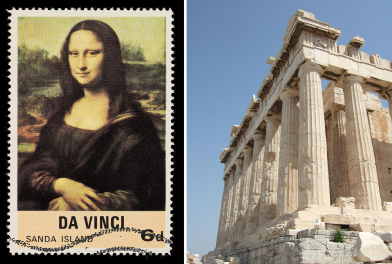Lesson 3: Irrational Numbers
Created by IMSreader
Module 2: Roots and Powers
Lesson 3: Irrational Numbers
Focus

left: © PictureLake/1053965/Fotolia (Mona Lisa); right: © Roman Rudyak/shutterstock (building)
In this lesson you will encounter a classification of numbers known as irrational numbers. Some examples of irrational numbers include ![]() (pi) and
(pi) and  , or Pythagoras’ constant. Irrational numbers have been used in mathematics to describe lengths and the ratios of certain lengths. For example, pi is an irrational number that represents the ratio of a circle’s circumference to its diameter. Similarly,
, or Pythagoras’ constant. Irrational numbers have been used in mathematics to describe lengths and the ratios of certain lengths. For example, pi is an irrational number that represents the ratio of a circle’s circumference to its diameter. Similarly,  is the length of the diagonal of a square with side lengths equal to one unit.
is the length of the diagonal of a square with side lengths equal to one unit.
Irrational numbers are also used in art and design. The golden ratio is a geometric proportion long thought to be the most aesthetically pleasing to the eye. You can find the golden ratio in the design of the Parthenon in Athens and in Leonardo da Vinci’s celebrated Mona Lisa, as well as other celebrated artwork and structures.
At the end of this lesson you will see how the properties of irrational numbers are well suited to code construction. You will also have the opportunity to use irrational numbers to create your own cipher.
Outcomes
At the end of this lesson, you will be able to demonstrate an understanding of irrational numbers by
- representing, using a graphic organizer, the relationship among the subsets of the real numbers (natural, whole, integer, rational, irrational)
- sorting a set of numbers into rational and irrational numbers
- determining the approximate value of an irrational number
- approximating the locations of irrational numbers on a number line, using a variety of strategies, and explaining the reasoning
Lesson Questions
- How are irrational numbers different from rational numbers?
- How are the properties of irrational numbers suited to code construction and other applications?
 Lesson Completion and Assessment
Lesson Completion and Assessment
As you work through each lesson, complete all the questions and learning activities in your binder using paper and pencil, clearly labeling your work (they refer to this as your course folder). These include the Are you Ready, Try This, Share and Self Check questions. Check your work if answers are provided. Remember that these questions provide you with the practice and feedback that you need to successfully complete this course.
Once you have completed all of the learning activities, take the Lesson Quiz. This is the assessment for each lesson and is located under the Assess tab or by using the Quizzes link under the Activities block.
** Note – Share questions may have to be done on your own depending on your learning situation**